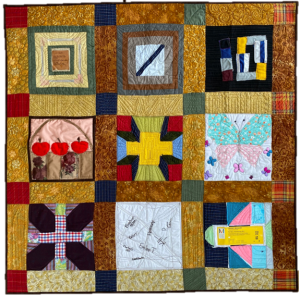
Students Quilt Identity in a Philosophy of Religion Classroom
 A quilt is an extraordinarily familiar and surprisingly profound item. Owned by many, quilts are remarkable cultural artifacts—a factor not lost on many of our students, who are from a region with a rich history of quilting. In the Fall of 2019, I asked my students to create a community quilt as a class project. The quilt was intended to be an accompaniment to a course that combined philosophy of religion and theology with a focus on human identity within the Christian tradition. Without any prior experience, the students in this course designed, sewed, and assembled a quilt in the space of three months. As a result, the abstract notions of the course took on the texture of rough fabric in their hands. While threading needles proved an enduring challenge, notions of fellowship and of relational identity came together like stitches on quilt-blocks, something readily accessible and extraordinarily familiar.
A quilt is an extraordinarily familiar and surprisingly profound item. Owned by many, quilts are remarkable cultural artifacts—a factor not lost on many of our students, who are from a region with a rich history of quilting. In the Fall of 2019, I asked my students to create a community quilt as a class project. The quilt was intended to be an accompaniment to a course that combined philosophy of religion and theology with a focus on human identity within the Christian tradition. Without any prior experience, the students in this course designed, sewed, and assembled a quilt in the space of three months. As a result, the abstract notions of the course took on the texture of rough fabric in their hands. While threading needles proved an enduring challenge, notions of fellowship and of relational identity came together like stitches on quilt-blocks, something readily accessible and extraordinarily familiar.
In exploring Christian notions of identity, the course takes Genesis 1 as its point of departure. This text is foundational for Christianity in terms of understanding the human condition and the connection between humanity and divinity. But what does “being created in God’s image” mean to the average twenty-year-old? In a secular university context, I have always found it challenging to connect students to what seem like lofty intellectual and devotional traditions. In the past, I have explored examples of Orthodox iconography as a way of providing a window into these traditions. Yet even an icon-making workshop with opportunities for hands-on experience was not as successful in bridging that gap as I had hoped. It appeared that it is not just doing or making that was important, but the accessibility of the object being constructed as well.
A quilt, by contrast, is extraordinarily accessible. While it provides warmth and comfort, its significance is much more than simple utility. Quilts are created according to long-standing traditions, embellished with artistic flourishes, and often given as gifts. Dignity quilts are used to clothe the sick and dying, while memory quilts might incorporate the clothing of those who have passed on. Most importantly, most students from this region own a quilt, which carries with it the memories of their childhood, connections with its maker, and for many, a sense of comfort and home.
I encouraged the students to choose a theme for their blocks that included something personal both figuratively—like a story or memory—and literally—like fabric or another material element from their lives. The results were startling. One student focused on the joys of the “local,” using fabrics dyed with local berries and bark from a native birch tree, printed with words from a resident poet. Another student created a more abstract block representing something of the depths opened by grief over a recent family loss. A member of the university football team cut small squares from a range of jerseys to create a mosaic of his player number and, in so doing, indicated the way in which his identity as an athlete brought together so many facets of his experience. A student who came from far away used fabric from clothing that connected her to her life back home. The quilt blocks demonstrated most effectively how history, community, context, and craft are enfolded within identity
Where in the past it had been challenging to prompt class discussions, this time students worked with their hands and conversation flowed freely and casually about the dense readings and complex ideas we covered. What is more, as the quilt came together, so did the class community. Sitting around the quilt sandwich became an opportunity for sharing, for connection, and for new understanding. The intricacies of the course materials became accessible because the students were exploring these materials via the metaphor and labour of quilting. This meant they explored their own identity and their connections to each other in parallel to the insights traditionally drawn from Genesis 1.
Ironically, in arranging the quilt squares, the students chose sashing that evoked the gold and brown colours of Orthodox icons. In effect, the quilt became a contemporary, lived expression of iconography, one that drew together the identity of the class community into an image that reflected something greater.
The completed quilt will not win any state fair competitions, and yet its crooked lines and rough finish speak of how intellectual complexities of identity are made plain in the place where one lives and by the work of one’s hands. This quilt project demonstrated the astonishing layers of connection possible when incorporating local cultural traditions and material practices into the abstract discourses of a third-level philosophy of religion course. It also created an analogue, where students could attempt new skills alongside new theoretical concepts and have the freedom to try and fail at both. As a student remarked, “The freedom to take risks and support one another in our physical explorations was mirrored in the discussions as well; students felt more free to take intellectual risks when discussing the texts because we had each already grown by failing in some way: sewing a quilt square upside down, or making wonky stitching, or struggling with the basics of threading a needle.”
Leave a Reply